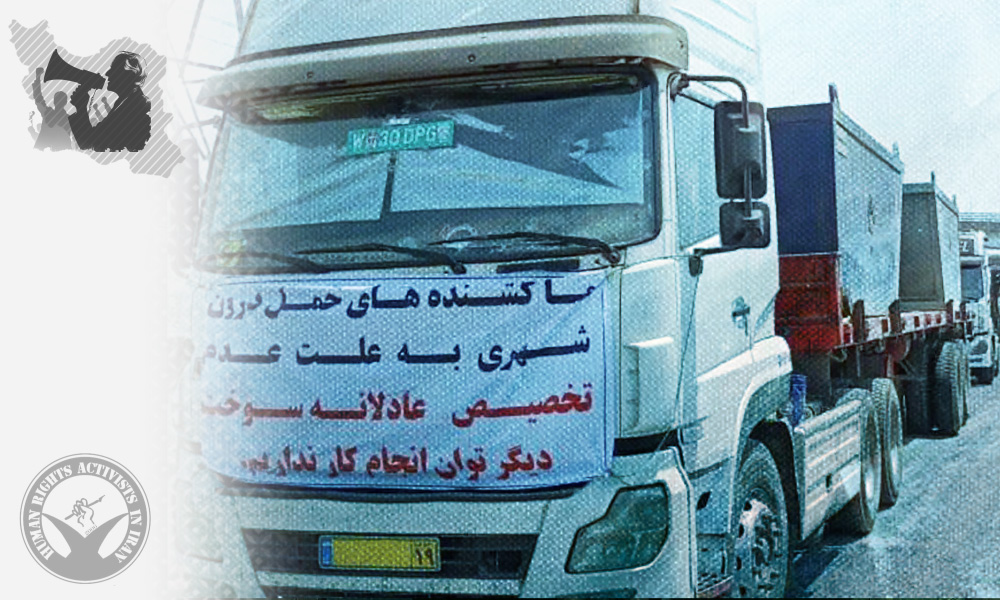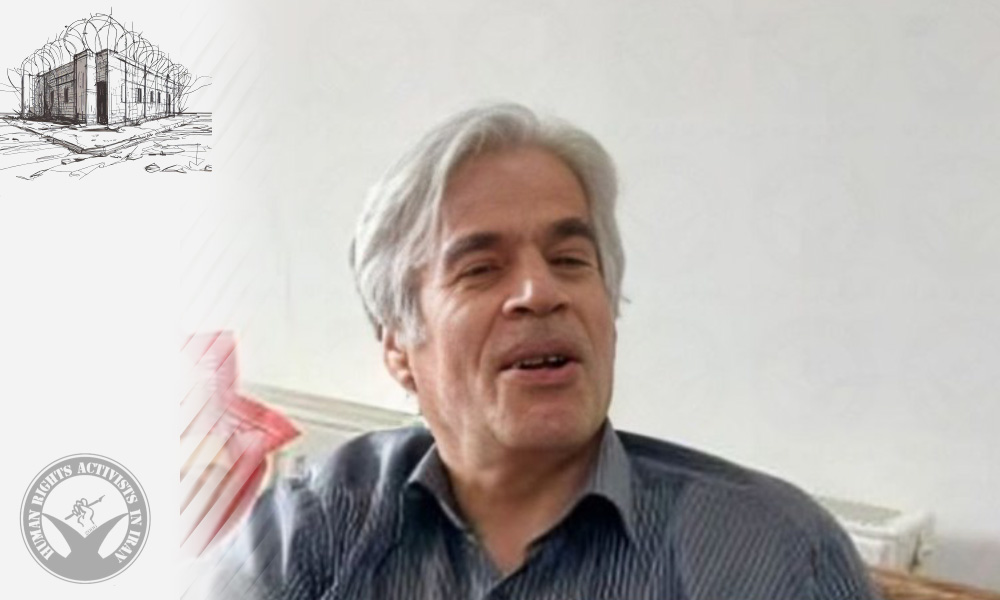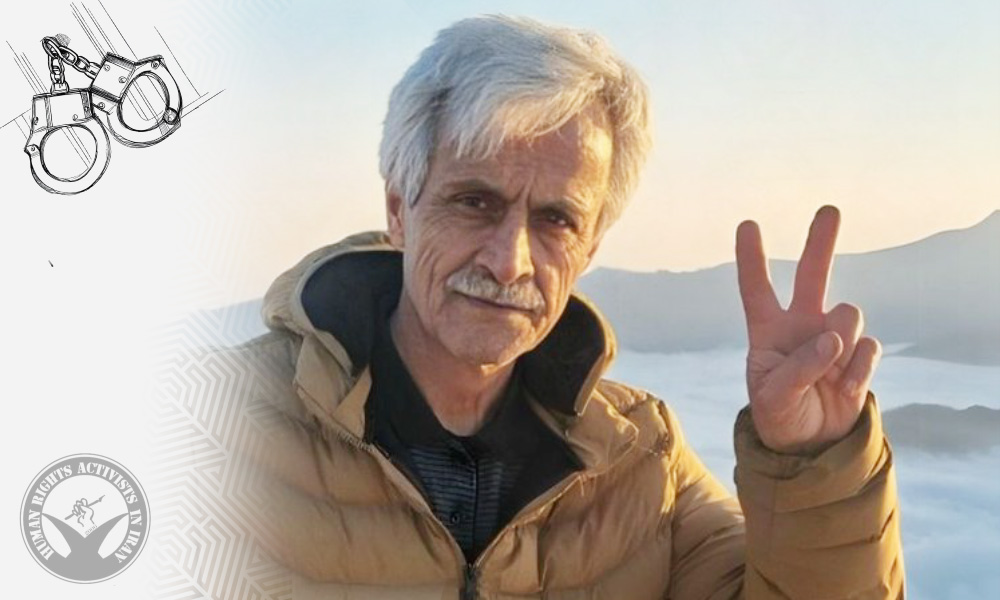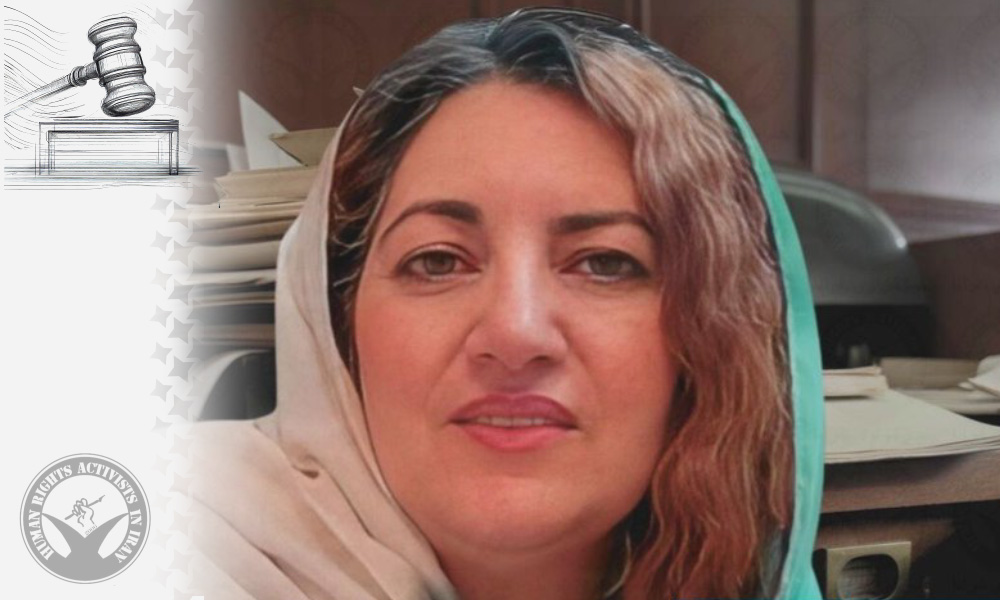HRANA News Agency – Truck owners across Iran have launched widespread protests that began on May 22 and have now spread to at least 163 cities. The movement, driven by mounting frustrations over rising operational costs, declining freight rates, worsening living conditions, and official neglect of their demands, has seen drivers halt operations by parking their trucks on roadways. In recent days, reports have surfaced of confrontations between security forces and protesters, including arrests and threats, fueling fears of an intensified crackdown on the movement. This report provides an in-depth look at the causes of the protests, their national spread, the government’s response, and the status of those detained.
According to HRANA, the news agency of Human Rights Activists in Iran, the truck owners’ strike has reached its seventh day, and roads in dozens of cities across the country remain empty.
Truck drivers refused to load cargo in protest against economic pressures. Problems cited include: the reduction of diesel quotas from 2000 to 100–200 liters per month, delays in fuel allocation, disruptions in distribution systems, increases in social security insurance premiums, low freight rates in comparison to heavy road tolls, lack of oversight on parts and repair prices, and the high cost of tires and oil. One of the drivers’ main demands is official recognition of the arduous nature of their work.
A Review of the Geographical Scope and Continuation of the Truck Drivers’ Strike
The nationwide truck owners’ strike began on Thursday, May 22, and in less than a week, became one of the most extensive labor protests in recent years. HRANA’s review of field reports indicates that the strike spread to at least 163 cities across the country within a week.
On the first day, Thursday, May 22, the strike was reported in the cities of Kermanshah, Arak, Bandar Abbas, Abbasabad (Darreh Shahr), Tabriz, Sirjan, Shiraz, Lorestan, Baft, Zarand, Marivan, Tehran, Mashhad, Zakho, Eslamabad-e Gharb, and Ilam.
On the second day, Friday, May 22, the strikes continued in Eslamabad-e Gharb, Bandar Abbas, Golpayegan, Fasa, Asadabad (Hamadan), Isfahan, Kazeroon, Najafabad, Tiran, Divandarreh, Darreh Shahr, Izeh, Kermanshah, Sirjan, Gol Gohar, Zanjan, Zarand, Shamsabad, Sanandaj, Tabriz, Yazdanshahr, Qazvin, Kerman, Arak, Baft, Kashmar, Lotfabad, Fooladshahr, Shahr-e Kord, Semirom, Asaluyeh, Mahshahr, Feyzabad (Mahvelat), and Marivan.
On Saturday, May 23, the strike continued in Dezful, Ghareh Bolagh (Fars), Zarand, Azna, Asaluyeh, Rumeshkan, Kazeroon, Sabzevar, Boroujerd, Neyshabur, Shabab, Yazd, Kermanshah, Mehriz, Saveh, Arak, Bandar Abbas, Mashhad, Fasa, Gahro, Shalamzar, Khorramabad, Lahijan, Shamsabad, Kangavar, Kerman, Ghazanchi, Eslamabad-e Gharb, Boneh Kalaghi (Neyriz County), Miyanshahr, Darreh Shahr, Salehabad (Hamadan), Bahabad, Semnan, Ardabil, Rafsanjan, Shahreza, Sanandaj, Isfahan, Tehran, Tabriz, Birjand, Darab, Bam, and Firuzkouh.
On the fourth day, the protests saw their widest spread, reported in the cities of Tehran, Bostanabad, Urmia, Ilam, Sarbisheh, Qazvin, Asfarvarin, Bam, Marvdasht, Khomeini Shahr, Mashhad, Bushehr, Ahvaz, Fooladshahr, Shirvan, Sanandaj, Najafabad, Omidiyeh, Khoy, Pakdasht, Bojnord, Ardabil, Malayer, Isfahan, Langarud, Naqadeh, Qom, Kermanshah, Maragheh, Saveh, Semirom, Hamadan, Shahrbabak, Salafchegan, Dorud, Bandar Abbas, Mahirood, Karaj, Aslanduz, Tabriz, Arak, Yazd, Sirjan, Farsan, Jahrom, Varamin, Yazdanshahr, Robat Karim, Shabab, Kangavar, Basmenj, Jowzam, Sarab, Dowlatabad, Zarindasht, Jafarabad (Ilam), Ghazanchi, Shiraz, Baharan, and Zahedan.
On the fifth consecutive day of protests, the labor action continued in Ardabil, Aq Qala, Torbat Jam, Karaj, Meybod, Kermanshah, Yazd, Divandarreh, Bandar Imam Khomeini, Isfahan, Sadra, Gilan-e Gharb, Shiraz, Shahroud, Aligudarz, Dehgolan, Abyek, Chabahar, Dashtiari, Chamgordan, Zarrinshahr, Najafabad, Fooladshahr, Bojnurd, Sabzevar, Hoveyzeh, Younesi, Sirjan, Chardavol, Rasht, Khoro, Neyshabur, Zanjan, Qazvin, Robat Karim, Laybid, Bostanabad, Shahrbabak, Lenjan, Saman, Morcheh Khort, Asaluyeh, Fariman, Sari, Koura, Akbarabad, Ezhiyeh, Varzaneh, Naqadeh, Ahvaz, Jajarm, Qasr-e Shirin, and Bandar Abbas.
On Tuesday, May 27, the cities of Arak, Saqqez, Semnan, Gotvand, Mahidasht, Kermanshah, Ahar, Gonabad, Isfahan, Shiraz, Shahr-e Kord, Tehran, Fariman, Pardis, Mahallat, Nasim Shahr, Shahreza, Kamyaran, Yazd, Boukan, Lenjan, Khorramdasht, Bandar Abbas, Borujen, Abadan, Ardabil, Boneh Kalaghi (Neyriz), Shahroud, Qasr-e Shirin, and Varamin witnessed continued strikes by truck drivers.
On Wednesday, May 28, the protest entered its seventh consecutive day in 26 cities including Abadan, Kerman, Khorramabad, Kermanshah, Sanandaj, Hamadan, Urmia, Qorveh, Bardsir, Borujen, Ahvaz, Bandar Imam Khomeini, Malayer, Isfahan, Sirjan, Asemanabad (Ilam), Boroujerd, Marivan, Sarpol-e Zahab, Anzali, Bandar Abbas, Mashhad, Qom, Saveh, Marivan, and Pardis.
The rapid expansion of the truck owners’ strike reflects a swift and widespread escalation in both geographic reach and regional participation. Starting in just 16 cities on the first day, the movement grew more than threefold within three days, surpassing 60 cities by the fourth day. Particularly striking was the broad geographic distribution—from border provinces like Kurdistan, Kermanshah, and Ilam in the west to central industrial centers such as Isfahan, Kerman, and Fars. The repeated involvement of certain provinces, along with the participation of both major cities and smaller towns, underscores that this is not a localized protest but a truly nationwide movement rooted in shared professional grievances.
Among the dozens of participating cities, some areas became main centers of the strike, with their names appearing consistently throughout the days of protest. Bandar Abbas was present every day and, as one of the country’s most important transit ports, played a key role in disrupting the transportation chain. Kermanshah also appeared on the list of protesting cities every day from the beginning. Isfahan, Tabriz, Shiraz, Arak, Zarand, Eslamabad-e Gharb, and Mashhad were also cities that remained active for more than three consecutive days, playing a central role in maintaining the protests. This consistent presence reflects strong solidarity and sustained protest in strategic points of the national transportation network.
According to HRANA’s field reports, blue Nissan pickup drivers also joined the protesting truckers between Monday and Wednesday, May 26–28, in at least five cities: Qazvin, Golpayegan, Mashhad, Quchan, and Neyshabur.
Arrests and Crackdowns:
Security agencies have adopted a repressive approach in response to the continuing truckers’ strike. In recent days, reports have emerged of threats and arrests of several protesting drivers in various cities. These actions have taken place despite the truck drivers demanding professional rights and improvements in their livelihoods, and their actions—especially in the form of a strike—fall within the scope of basic labor and civil rights.
On Wednesday, truck driver Sediq Mohammadi was arrested by the Sanandaj Intelligence Office for participating in the nationwide strike and was transferred to an unknown location. Additionally, yesterday, truck driver Shahab Darabi from Eslamabad-e Gharb was also arrested for joining the nationwide strikes. He had posted a video on his Instagram page in support of the protest movement. The location of Mr. Darabi remains unknown.
On the fourth day of the strikes, the Union of Truck Drivers and Trucking Organizations of Iran issued a statement claiming that security forces violated protesters’ rights by attacking them at the Sanandaj terminal with pepper spray and detaining several individuals. The truckers’ organizations condemned this as a repressive act and criticized officials’ performative actions, stating that instead of addressing the core issues, they aim to silence dissent.
In a separate statement, the same union reported that 11 drivers were arrested in Kermanshah, marking another instance of repression against professional demands. This action prompted a protest response from hundreds of drivers in front of the provincial governor’s office in Kermanshah. The union emphasized that these crackdowns are taking place in response to legitimate demands such as fair freight rates, insurance, and road safety, and reflect the government’s inability to address basic human needs and increasing pressure on protesters.
The prosecutor of Shiraz also announced the arrest of several protesting drivers, accusing them of disrupting transportation. Without specifying the number of detainees, he claimed that these individuals had “deliberately and systematically disrupted the transportation system.”
The Islamic Republic of Iran Broadcasting (IRIB) also reported the arrest of two truck drivers in connection with the recent protests. In a video released on the matter, the two individuals are seen objecting to the continued work of a truck driver on one of the roads in Khuzestan Province before being arrested by security forces. In the video—whose recording conditions are unclear—the detainees confess that over the past four days, they attempted to encourage other drivers in various parts of Khuzestan to join the nationwide strike.
Truck Drivers’ Accounts of Economic Pressures and Professional Demands:
In this part of the report, we spoke with several protesting drivers; however, due to security concerns, their full names have been withheld, and only their first names are mentioned.
Ahmad, a truck driver in Bandar Abbas who has been on strike for the seventh consecutive day, told HRANA: “In previous years, the maximum increase in drivers’ insurance premiums was about 600,000 tomans, but suddenly it has jumped from 1.5 million to 3.4 million tomans. Under these conditions, how can a driver afford such an amount? We are just drivers, not vehicle owners.”
Mohammad, another protesting driver from Shiraz, told HRANA: “Last year, we bought tires for 24 million tomans, but this year, the same tires cost 60 million. Oil used to cost 735,000 tomans, now we have to pay between 2.5 to 3 million. The fuel quota has also become extremely limited, and we are forced to buy it on the open market at high prices. Moreover, unloading cargo sometimes takes 20 days or even a month. Under these conditions, how is a driver supposed to cover his expenses?”
A transportation expert, in a call with HRANA, referring to the impact of the strike on truck drivers’ families, stated: “The Road Maintenance and Transportation Organization has given implicit approval for revising the ton-kilometer rate and has begun technical reviews to increase it. Members of parliament have directly stepped in to pursue drivers’ demands. Officials from the Social Security Organization have officially responded to the drivers’ insurance issues. Domestic and foreign media attention to the truckers’ demands are among the key outcomes of this nationwide movement.”
Hiwa, another trucker from Sanandaj, mentioned during a phone call the emergence of a wave of solidarity among other drivers, including blue Nissan pickups, small trucks, and other freight fleets. He added that this strike has raised public awareness of the difficult living and working conditions drivers endure.
Mahmoud, a truck driver from Sirjan, emphasized the significant role of middlemen in the crisis of the sector, telling HRANA: “If you only address the brokerage issue, 90% of our problems will be solved. That one issue is enough. The presence of brokers in the freight distribution process has reduced drivers’ income and created injustice in the allocation of loads. These intermediaries, by taking commissions and manipulating the market, set freight rates in their own favor without considering the heavy costs imposed on drivers. The lack of effective oversight of brokers’ operations and the lack of transparency in the freight distribution system force drivers to accept fares that don’t even cover their running costs. This situation has not only reduced their income but has also severely diminished motivation to continue in this profession.”
Another protesting driver, who wished to remain anonymous, commented on the government’s response to the truckers’ strike: “Because these strikes have a direct impact on the supply chain and the national economy, they have always been met with particular sensitivity from the government. These actions not only disrupt the economic flow but could also spark broader nationwide protests. For this reason, the government tries with all its resources to suppress, divert, or control these actions. Experience has shown that the government uses a combination of negotiation, unfulfilled promises, and repression in response. For instance, during the 2018 strike, more than 100 people were arrested, and in 2022, some drivers received harsh sentences ranging from one to ten years in prison.”
Reactions:
In response to the truck drivers’ strikes, Mohammad Bagher Ghalibaf, Speaker of the Islamic Consultative Assembly, described truckers as a fundamental pillar of the supply chain and called for immediate attention to their problems. Mehdi Khezri, Deputy Head of the Road Maintenance and Transportation Organization, also promised that drivers’ base fuel quotas would be maintained and that the issue of reductions would be re-evaluated. He reported ongoing negotiations with the Social Security Organization to provide insurance discounts for drivers and acknowledged that the 45% increase in insurance premiums at the start of the year had triggered protests among truck drivers.
Reza Akbari, head of the Road Maintenance and Transportation Organization, referring to the truck drivers’ strike, claimed: “A minority of drivers are trying to stir unrest, and these actions are the result of incitement by hostile foreign media that aim to portray the country’s roads as insecure.”
The Chief Justice of Ilam Province, threatening protesting drivers, stated: “Those who disrupt the freight transport process or damage trucks will face legal action without any leniency.”
Fars News Agency, affiliated with security institutions, responded to reports about the skyrocketing insurance premiums for truckers by calling them “rumors” and claimed that the changes were made under the framework of the Seventh Development Plan Law and aimed to scale back government support to the level of the legally mandated minimum wage set by the Ministry of Cooperatives, Labor, and Social Welfare.
The representative of Khoy also issued a verbal warning in parliament, saying: “The country’s transportation fleet is on the verge of collapse due to years of neglect, lack of modernization, and absence of meaningful support for the hardworking community of drivers.”
The acting deputy for economic coordination at the Khuzestan Governor’s Office announced on Sunday the formation of a special committee to support the province’s truck drivers. He said the committee, chaired by the Khuzestan Industry, Mine, and Trade Department with participation from all relevant bodies, would address issues such as fuel provision, motor oil, insurance, and spare parts. Additionally, the governor of Shush announced that the demands of the county’s truck drivers were presented and would be pursued in a meeting with the Khuzestan governor.
Fatemeh Mohajerani, government spokesperson, announced that the issues faced by truckers were raised in a cabinet meeting. Reza Akbari, head of the Road Maintenance and Transportation Organization, also promised that within a month, the problems of fuel and insurance for truck drivers would be resolved. The Director General of the Fars Province Road Maintenance and Transportation Organization stated that the drivers’ demands were under review and announced a 25 to 30 percent increase in transportation fares by the end of June.
The ongoing nationwide strike by truckers, marked by strong professional solidarity across dozens of cities and joined by many light transport drivers, reflects more than just a reaction to economic hardship. It signals a broader protest against the systemic neglect of fundamental professional and human rights. In response to these legitimate demands, the government has resorted to intimidation, arrests, and efforts to shape public perception through state media. Yet the truckers’ movement has grown into one of the most significant expressions of civil resistance in recent years, extending beyond basic citizenship rights to challenge deeper injustices.













